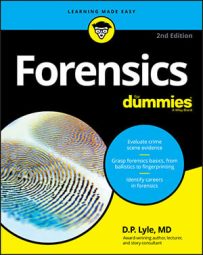Not only do pen and paper leave behind clues about the origin of a document but various mechanical devices do also. Typewriters, printers, and copy machines often leave distinguishing marks on the typed or copied page. These marks may reveal that a document has been altered or help investigators find out exactly which machine produced the document in question.
Hunting and pecking for clues
People frequently use typewriters to write threatening letters and ransom and extortion notes. Criminals often are under the mistaken impression that doing so makes the letter untraceable. Not true. When a typewriter is involved, the document examiner tries to
Determine the make and model of the typewriter
Match up the note with a suspect typewriter, if one is available
Identifying the make and model means that the examiner must have access to a database of typefaces used in various typewriter models, new and old. Most manufacturers use either pica or elite typefaces, but the size, shape, and style of the letters vary, making identification of the manufacturer and model possible. This greatly narrows the search for the exact machine that produced the document.
Unfortunately, typewriters have given way to computers, which connect to printers that may use daisy-wheel, dot-matrix, ink-jet, or laser technologies. These machines vary so little that examiners often can't distinguish one from another.
To determine whether a particular typewriter produced a questioned document, examiners search for individual characteristics that can include misaligned or damaged letters, abnormal spacing before or after certain letters, and variations in the pressure applied to the page by some letters. For example, certain letters can have telltale nicks or spurs that are imprinted on the page, or they can lean to one side or print slightly higher or lower than the others. These defects can be compared to a sample from a suspect typewriter and thus offer powerful individualizing characteristics.
To compare a typed document to a particular machine, the examiner types a comparison document using that machine. When doing so, the examiner uses a ribbon similar in type and condition to the one used to produce the original document. The reason: A worn or lightly inked ribbon reveals minor defects in the typeface, whereas a heavily inked, new ribbon may obscure them.
Typewriters that use ribbons can help the examiner link the typewriter to the document. If the typewriter has a single-pass ribbon and the same ribbon that was used to type the document still is in place, the police can simply read the message from the ribbon itself. Even if the ribbon has been used for several passes, investigators may be able to retrieve portions of the message.
What if the criminal used the original typewriter to add a line or a paragraph to a document? How does an examiner know when that has happened? Because the typeface would be identical, the examiner may not be able to tell whether an alteration occurred. However, when a page is placed into a typewriter a second time, the alignment often is off, and although it may only be slightly askew, the examiner can place a specially made glass plate with an etched grid pattern over the page. This reveals any imperfection in the alignment of the added lines or paragraphs.
Finding distinctive traits in copies
A copy machine duplicates an image from one page onto another through a complex series of events.
First, a lens focuses the image of the original page onto a drum that is charged with static electricity and coated with selenium or another light-sensitive substance. The drum retains the image as it's bathed with a toner powder that attaches to the surface of the drum in proportion to the strength of the electrostatic charge. This toner image then is transferred to the blank page, which, in turn, is exposed to a fixing agent.
Investigators can sometimes match a photocopied document to a particular copy machine because the mechanisms within the machine that pull the paper onto and remove it from the copy surface can leave marks on the page. Likewise, the cover glass, camera lens, or drum may have scratches or defects that mark every page that it produces. Occasionally, these marks appear on a photocopied page, and investigators can identify and match this marked page to the machine that produced it.

